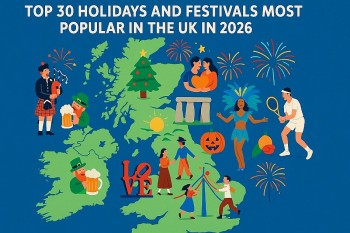When is Winter Solstice and the Shortest Day of the Year in the UK?
 |
| Winter Solstice 2024 - The Shortest Day of the Year |
Winter solstice is a celestial event that marks the shortest day and the longest night of the year in the Northern Hemisphere. For the UK, this phenomenon not only signals the official start of astronomical winter but also holds deep cultural, historical, and scientific significance.
What is the Winter Solstice?
The term "solstice" originates from the Latin words sol (sun) and sistere (to stand still). During the winter solstice, the sun appears to halt its southward movement in the sky before reversing direction. This occurs due to the Earth's axial tilt of 23.5 degrees, which positions the Northern Hemisphere at its maximum angle away from the sun.
The winter solstice is marked by the sun’s lowest elevation in the sky at noon, resulting in minimal daylight hours. For the UK, this day typically occurs on December 21st or 22nd, depending on the year. In 2024, the winter solstice will occur on December 21st at precisely 9:21 AM GMT.
Daylight Duration in the UK
During the winter solstice, the UK experiences its shortest daylight hours. For example, in London, the day is approximately 7 hours, 49 minutes, and 42 seconds long. In more northern locations like Edinburgh, daylight is even shorter, lasting around 6 hours and 57 minutes. This is in stark contrast to the summer solstice in June, where London enjoys over 16 hours of daylight.
After the winter solstice, the days gradually begin to lengthen, offering a sense of hope and renewal as the sun climbs higher in the sky. By the time the vernal equinox arrives in March, day and night will be of equal length.
Why Does the Winter Solstice Occur?
The Earth orbits the sun on an elliptical path while tilted on its axis. This axial tilt is responsible for the changing seasons and the varying lengths of days and nights throughout the year. During the winter solstice, the Northern Hemisphere is tilted furthest away from the sun, resulting in the sun's rays striking the hemisphere at their most oblique angle.
This tilt also affects the altitude of the sun in the sky. At noon during the winter solstice in London, the sun reaches an elevation of only about 15 degrees above the horizon. This low angle contributes to shorter days, longer shadows, and the characteristic dim light of winter.
Astronomical vs. Meteorological Winter
It’s important to distinguish between astronomical and meteorological definitions of winter:
-
Astronomical Winter: Defined by Earth’s position in its orbit, it begins on the winter solstice (December 21st or 22nd) and ends on the vernal equinox (around March 20th).
-
Meteorological Winter: Based on the Gregorian calendar and average temperatures, meteorological winter encompasses December, January, and February.
The difference between these definitions explains why the coldest weather in the UK often occurs weeks after the solstice. This phenomenon, known as seasonal lag, is due to the time it takes for Earth’s land and oceans to cool down fully after absorbing solar energy during earlier months.
Cultural and Historical Significance in the UK
The winter solstice has been celebrated for thousands of years, long before the advent of modern calendars or scientific explanations. Early humans recognized the significance of this celestial event and incorporated it into their rituals and structures.
Stonehenge and the Winter Solstice One of the most famous examples of solstice-related architecture is Stonehenge, located in Wiltshire, England. This prehistoric monument aligns perfectly with the sunrise on the winter solstice, suggesting that ancient people used it to track the seasons. Even today, thousands of visitors gather at Stonehenge every December to watch the solstice sunrise and participate in modern-day pagan ceremonies.
Yule and Ancient Festivals In pre-Christian times, the winter solstice was celebrated as Yule by the Germanic peoples. Yule traditions, such as lighting candles, burning the Yule log, and feasting, were symbolic of hope and the return of the sun. Many of these customs were later integrated into Christmas celebrations.
Modern Observances Today, the winter solstice is observed with both reverence and festivity. In the UK, gatherings at Stonehenge remain a highlight, attracting druids, pagans, and curious onlookers. Many also use the day as an opportunity to reflect, set intentions, and honor the natural cycles of the Earth.
Impact of the Winter Solstice on Daily Life in the UK
Seasonal Affective Disorder (SAD) The lack of daylight during the winter months can affect mental health, leading to a condition known as Seasonal Affective Disorder (SAD). This disorder, linked to reduced exposure to sunlight, can cause feelings of depression, fatigue, and difficulty concentrating. The winter solstice, while the darkest day, also symbolizes the turning point towards longer and brighter days, offering hope to those affected by SAD.
Energy Consumption The UK sees a significant rise in energy usage during the winter solstice period due to increased reliance on artificial lighting and heating. Awareness of energy efficiency and sustainable practices is particularly important during this time to reduce environmental impact.
Wildlife and Nature The winter solstice also affects the behavior of wildlife in the UK. Animals such as hedgehogs and dormice remain in hibernation, while others adapt to the limited daylight by foraging efficiently. The solstice marks a time of survival and adaptation in nature.
Global Perspectives on the Winter Solstice
While the winter solstice is observed globally, each culture has its unique way of marking the occasion:
-
Dongzhi Festival (China): Celebrated with family gatherings and traditional foods like tangyuan (sweet rice balls), the festival emphasizes unity and hope for brighter days.
-
Shab-e Yalda (Iran): This Persian festival involves staying up all night, sharing poetry, and eating pomegranates and nuts to celebrate the triumph of light over darkness.
-
Inti Raymi (Peru): In the Southern Hemisphere, the winter solstice occurs in June and is celebrated as a festival of the sun by the indigenous Andean communities.
These diverse celebrations highlight the universal significance of the solstice in connecting humanity with the cycles of nature.
Scientific Observations and Advancements
In modern times, the winter solstice offers an opportunity for astronomical studies and public engagement with science. Planetariums and observatories across the UK often host events to explain the solstice and its role in Earth’s orbit. Additionally, the solstice serves as a reminder of humanity’s shared dependence on the rhythms of the natural world.
Looking Forward: What the Solstice Symbolizes
The winter solstice is more than just an astronomical event. It symbolizes rebirth, resilience, and the promise of longer, brighter days ahead. For the UK, it is a time to connect with nature, honor ancient traditions, and celebrate the enduring cycles of life.
As the days begin to lengthen after December 21st, the winter solstice reminds us that light always follows darkness. This timeless message resonates across cultures and centuries, offering a profound sense of continuity and hope.
Conclusion
The winter solstice, marking the shortest day of the year in the UK, is a moment of scientific wonder and cultural significance. From the ancient alignment of Stonehenge to modern-day gatherings and celebrations, it bridges the gap between the past and present. As the turning point in the year, it invites reflection, celebration, and a renewed appreciation for the natural cycles that govern our lives.
The solstice is not merely the shortest day but a powerful symbol of hope, resilience, and the enduring promise of brighter days ahead.
 When Does Summer Start/End: Solstices, Equinoxes, Best Quotes and Facts About When Does Summer Start/End: Solstices, Equinoxes, Best Quotes and Facts About Summer is just one step away, and we cant wait for our holidays to come. When does summer start/end this year and next years? Keep ... |
 When Does Winter Start/End: Solstice, Best Quotes and Facts When Does Winter Start/End: Solstice, Best Quotes and Facts Winter - the last and coldest season of the year, where everything sinks into a deep sleep under layers of snow, waiting for spring to ... |
 December 2024 US Calendar: Special Days, Full List of National Holidays and International Events December 2024 US Calendar: Special Days, Full List of National Holidays and International Events Each December day in the US offers opportunities for reflection, celebration, and family connection. December is full of meaning, unity, and goodwill, from religious to ... |
 What Is the Summer Solstice - the Longest Day of the Year: Facts and Celebrations? What Is the Summer Solstice - the Longest Day of the Year: Facts and Celebrations? As the days lengthen and temperatures warm, people around the globe prepare to celebrate the summer solstice, the longest day of the year. So what ... |
 What is December Solstice: Dates, Causes, and Fun Facts What is December Solstice: Dates, Causes, and Fun Facts There are two solstices every year: one in December and one in June. The December solstice marks the shortest day north of the equator and ... |


























